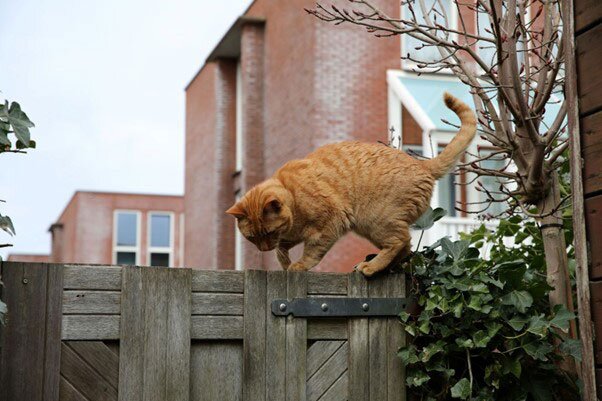As cat lovers, we all want our feline friends to experience the sights, sounds, and scents of the great outdoors — but without the risks. Enter the catio. These clever outdoor enclosures offer a safe and stimulating space for cats to explore, stretch, and sunbathe, all while staying protected from traffic, predators, and other hazards.

In this guide, we’ll walk you through what catios are, how to make a catio using wire mesh, and explain what it takes to create a catio that suits your space, your budget, and most importantly, your cat. We’ll cover:
What Is a Catio?
A catio (short for "cat patio") is an outdoor enclosure designed specifically for cats. Built to attach to your home from a window, door, or simply an outdoor wall, a catio provides a secure space where indoor cats can enjoy the outdoors without the dangers that come with free roaming.
Catios can range from modest window boxes to large, walk-in structures with multiple levels. Some are designed to blend into a garden setting; others can become a key feature of your patio. But they all serve one goal: to give cats safe access to fresh air and stimulation.
Why Build a Catio?
There are many reasons cat owners across the UK might build a catio. Outdoor cats are generally considered to have a shorter lifespan than indoor cats, as they face risks from traffic, foxes, dogs, poisoning, and even theft — although this is disputed. Either way, catios eliminate these dangers and allow your cat to enjoy the fresh air safely.

Cats are natural explorers, and a well-designed catio gives them space to climb, scratch, and observe the world. Birdwatching, basking in the sun, and sniffing fresh scents are all forms of enrichment that support a cat’s mental wellbeing. As a result, indoor cats with outdoor access via a catio may exhibit fewer behavioural issues, such as scratching furniture or meowing to go out.
But catios can protect more than just your pet. Cats are predatory animals, and allowing your cat to roam freely can have an impact on local wildlife — in fact, cats are estimated to hunt and kill 275 million prey animals a year, including 55 million birds. Using a catio could help your cat and your local ecosystem exist in harmony. If you have any outdoor pets like chickens or rabbits, this will help keep those safe from your cat’s primal instincts too.
How to Build a Catio
If you're wondering how to build your own catio, it might be easier than you think. Most catios are DIY-friendly and can be built using simple wire mesh, basic wooden frames, and tools you may have in your toolbox already. Here’s a quick checklist:
- Treated wood or metal framing
- Galvanised wire mesh
- Screws, fixings, and brackets
- Weatherproof roofing or tarpaulin
- Cat-friendly accessories like hammocks, platforms, and cushions
If you don’t have a garden or would prefer something compact, you could consider a window-mounted catio. This is a small box-style frame that can fit over a window from the outside, with the window, a cat flap, or tunnel for access.
To attach a catio or window-mounted catio to your house, use brackets or masonry screws and always ensure the weight of both the full catio and your cat is supported. It’s worth consulting a professional if your walls are brick or if you're uncertain about load-bearing limits.
Step-by-Step: How to Build a Catio
Step 1: Choose Your Location
Think about where your cat currently looks longingly outside. You’ll just need an exterior wall for freestanding catios, but ideal access points for fitted catios include:
- A ground-floor window
- A garden door
Try to avoid turning balconies into catios, as these may present safety risks, especially if there’s any chance your cat could slip through or fall.
Step 2: Decide on the Size
Wondering how big should a catio be? There’s no one-size-fits-all. A small catio might be a window box with enough room to lounge, while a large one could be a multi-level garden enclosure your cat can truly roam in. Think about how many cats you have, their activity levels, and your available space. As a general rule of thumb, try to allow for a minimum of 1–2 metres per cat.
Step 3: Build a Frame
Timber is a popular material for framing catios, especially treated wood suitable for outdoor use. Build a simple box shape as large as you like using the guidance above, then add shelves or ramps inside for vertical enrichment.
Step 4: Add Wire Mesh
The choice of mesh is crucial. A galvanised welded wire mesh is best for catios, as it’s strong, weather-resistant, and bite-proof. Make sure the holes are small enough to prevent your cat slipping through or predators getting in — we generally suggest a 25 x 25mm hole and 1.6mm thick wire mesh for cats as this is small enough to prevent your cat from getting their head stuck in the mesh, and also strong enough to keep foxes out. We would recommend choosing a European-made mesh, as this material runs straighter making it easier to fix onto a frame using Fix the mesh securely to the frame using staples or cable ties.
Step 5: Add Access
Consider whether you’ll add doors or create an opening that allows your cat to move freely between the house and the catio. Many owners build a small cat flap tunnel from the house into the enclosure, but you may find it easier to simply carry or guide your cat towards the catio door and take them back inside when they’re ready to go in.
Step 6: Make It Safe
Remember, safety is paramount when building any cat enclosure. To make your catio safe, ensure that it has a roof — you’ll be surprised how high a cat can climb! A covered roof also provides protection from the elements, including the sun and sudden showers.
Ensure all joins and mesh fittings are fully secure, and always make sure you attach your wire mesh to the outside of the frame. This will help ensure that any rough edges are kept away from your cat, and makes the catio more secure to outside predators.
If your cat is an escape artist, regularly inspect the catio for signs of digging, bending, or damage, and consider a double-door system to avoid escapes when entering.
What to Put in a Catio
Once you’ve built the basic structure, it’s time to turn your catio into a paradise for your pet.
- Shelter and shade: Even if your catio is in a shaded spot, your cat will need some shelter from the elements. Add a small waterproof hideaway or use roofing sheets for partial coverage.
- Levels and climbing opportunities: Cats love vertical space. Add ramps, climbing posts, hammocks, and floating platforms so they can perch, stretch, and observe.
- Toys and enrichment: Add hanging toys, balls, and scratching posts to keep your cat mentally and physically stimulated.
- Natural touches: Incorporate safe plants like catnip, spiderplants, or lemongrass, along with real logs or branches for scratching and scent-marking.
- Cosy spots: Outdoor cushions, blankets, or a heated mat (safely wired and covered) can help your cat stay comfortable even on cooler days.

How Much Does a Catio Cost?
The cost of building a catio varies widely based on size, materials, and whether you DIY or go custom. Here’s a rough guide:
- Small DIY catio (window box): £50–£150
- Medium freestanding catio: £200–£500
- Large walk-in catio with roofing and multiple levels: £500–£1,500+
- Custom-built luxury catios: £2,000+
Remember that materials like mesh and treated timber offer long-term durability, so it’s worth investing in quality upfront.
On a budget? Building a catio doesn’t have to be expensive. If you’re looking for how to build a catio for cheap, here are some money-saving tips:
- Upcycle: Use old shelving, pallets, or leftover timber.
- Start small: A modest window catio can cost very little and still offer enrichment.
- Modular builds: Start with a small enclosure and expand over time as your budget allows.
Catio ideas and inspiration
Looking for design ideas? Whether you want to build a simple escape-proof haven or a palace fit for a feline king, here are a few concepts:
- Luxury catios: Think multi-level towers, climbing bridges, water features, and integrated cat tunnels.
- Catio corridors: Narrow runs that stretch along the side of your house or fence, giving cats space to move freely.
- Freestanding garden catios: Ideal if you can’t attach anything to your property — these sit independently and can be moved if needed.
- Rustic retreats: Use natural wood, logs, and extra foliage for a more organic vibe.
- Apartment-friendly catios: Even if you don’t have a garden, a safe, compact catio outside a ground-floor flat can offer the perfect outdoor experience.
Whether you’ve got a curious kitten or a senior indoor cat who loves the sun, a catio can be an incredibly rewarding addition to your home. It protects your cat, gives them new experiences, and offers peace of mind for you. By using durable, secure wire mesh and a thoughtful design, you can create a catio that not only keeps your cat safe but also makes them the envy of the neighbourhood.




